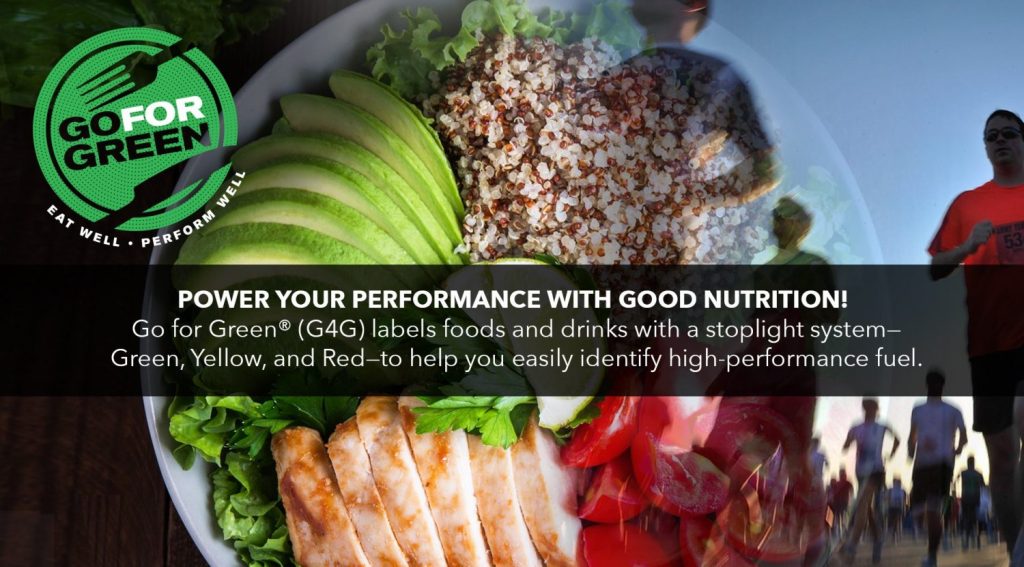Go for Green® (G4G) is a joint service performance-nutrition initiative that improves the food environment where Service Members live and work. G4G prompts better food and beverage selections with the aim to optimize performance, readiness, and health.
Is what you’re eating helping or hindering your performance? If you’re feeling low in energy, underperforming in the gym, or struggling through your workday, then choose better “fuel.” Go for Green® (G4G) makes it easy to find high-performance foods and beverages to boost your fitness, strength, and health. Look for DoD’s revised G4G initiative in your dining facility or galley to help make nutritious choices that fuel your body and mind, optimizing your energy and performance.
G4G labels foods and beverages with a stoplight system—Green, Yellow, and Red—to identify your best choices for peak performance. Foods are labeled with Low, Moderate, or High sodium symbols to point out sodium content too. Use these tips to build your energy-boosting plate:
- Aim to fill half your plate with Green-coded foods. You can find healthy, Green-coded choices in every food group: grains, fats, proteins, fruits and vegetables, and dairy.
- Eat consistently to keep your energy up. For best results, include Green-coded foods and drinks with every meal and snack—and stick to a schedule when possible.
- Make nutrient-rich foods the easy choice at home and work. You’re more likely to eat what’s easily available, so choose foods that make you want to get up and go. Stock your fridge with Green-coded items, fill your kitchen cabinets with minimally processed foods, and keep a stash of healthy snacks in your desk drawer.

Green-coded foods do more than just fuel your body. They can improve focus, recovery, and also enhance mood. Find out more here:http://ow.ly/PLwm2 #GetGotG4G
Go For Green® Menu Coding
The G4G Guide to Foods and Beverages lists foods in each of the Green, Yellow, and Red categories. Here are some commonly asked questions about food and beverage coding.
Why is chocolate milk a Yellow-coded beverage? G4G promotes it as a healthy recovery drink after workout/PT.
Due to its protein and carbohydrate content, chocolate milk can be an appropriate recovery drink after intense or long workouts. However, if chocolate milk is consumed without the benefit of exercise, its sugar and calories might be too much for a healthy eating plan.
Why is Gatorade a Yellow-coded beverage?
Sports drinks such as Gatorade are coded Yellow because they replenish fluids lost during excessive perspiration. Sports drinks are formulated for use with exercise greater than 60 minutes or extreme conditions (heat or humidity). If you are not exercising or living in extreme environmental conditions, then sports drinks might be too high in calories and sugar for your eating plan.
Why are coffee and tea coded Yellow? How about if I drink them plain (without added sugar or cream)?
Coffee and tea are coded Yellow due to their caffeine content. Some service members might need to limit their caffeine intake due to health conditions, medications, caffeine sensitivity, or sleeping difficulties. Caffeine-free beverages, such as herbal tea, are coded Green since they naturally do not contain caffeine.
Why is iceberg lettuce coded Green?
Iceberg lettuce is Green-coded because it is minimally processed, contains some fiber, and doesn’t contain saturated fat or added sugar. Dark, leafy-green vegetables such as spinach and Romaine lettuce (also Green-coded) contain higher nutrients.
Why is BBQ pork coded Yellow not Red?
Like many meats, pork can be very lean (Green-coded) or high in fat (Red-coded) depending on its cut. BBQ sauce contains sugar, but less than the amounts in sugary drinks or desserts. Overall, pork is a good source of protein and lower in saturated fat than other Red-coded meat dishes.
Why is yogurt, a Yellow-coded dairy product, not Green?
Many yogurts contain added sugar or artificial flavors—putting these products in the Yellow category. Plain, low-fat yogurt is Green-coded because it doesn’t contain high amounts of added sugar or artificial sweeteners. All yogurts have some naturally occurring sugars.
Why are high-sodium foods such as olives, pickles, and soup coded Green?
G4G 2015 has a two-part coding system. Nutritional quality (Green, Yellow, and Red) is coded separately from sodium codes (Low, Moderate, and High). Sodium content does not affect the color code. A high-sodium product can be coded Red just as a low-sodium product can be coded Red (e.g., pie or fruit punch).
Why isn’t every vegetable coded Green?
Most vegetables are coded Green due to their high nutrients and low sugar, calories, and saturated fat. Red-coded vegetables include large amounts of added butter, lard, cheese, or cream sauce.
